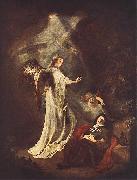Wholesale Oil Painting No Minimum |
|||||||||||
|
|
|||||||||||

|
|||||||||||
|
|
|
||||||||
BOL, FerdinandDutch Baroque Era Painter, 1616-1680 Ferdinand was born in Dordrecht as the son of a surgeon, Balthasar Bol.[2] Ferdinand Bol was first an apprentice of Jacob Cuyp in his hometown and/or of Abraham Bloemaert in Utrecht. After 1630 he studied with Rembrandt, living in his house in Sint Antoniesbreestraat, then a fashionable street and area for painters, jewellers, architects, and many Flemish and Jewish immigrants.[3] In 1641 Bol started his own studio. In 1652 he became a burgher of Amsterdam, and in 1653 he married Elisabeth Dell, whose father held positions with the Admiralty of Amsterdam and the wine merchants' guild, both institutions that later gave commissions to the artist. Within a few years (1655) he became the head of the guild and received orders to deliver two chimney pieces for rooms in the new town hall designed by Jacob van Campen, and four more for the Admiralty of Amsterdam. Portrait of a Woman Dressed as a Huntress by Ferdinand Bol, courtesy Figge Art MuseumBy this time Bol was a popular and successful painter. His palette had lightened, his figures possessed greater elegance, and by the middle of the decade he was receiving more official commissions than any other artist in Amsterdam.[4] Godfrey Kneller was his pupil.[5] Bol delivered four paintings for the two mansions of the brothers Trip, originally also from Dordrecht.[6] Bol's first wife died 1660. In 1669 Bol married for the second time to Anna van Arckel, widow of the treasurer of the Admiralty, and apparently retired from painting at that point in his life.[7]In 1672 the couple moved to Keizersgracht 472, then a newly designed part of the city, and now the Museum van Loon. Bol served as a governor in a Home for Lepers. Bol died a few weeks after his wife, on Herengracht, where his son, a lawyer, lived. Probably his best known painting is a portrait of Elisabeth Bas, the wife of the naval officer Joachim Swartenhondt and an innkeeper near the Dam square. This and many other of his paintings would in the 19th century be falsely attributed to Rembrandt. |
||||||||
|
|
||||||||
Jacob s Dream
Jacob s Dream Painting ID:: 5216 |
c. 1642
Oil on canvas, 128,5 x 97 cm
Gemäldegalerie, Dresden c. 1642 Oil on canvas, 128,5 x 97 cm Gemäldegalerie, Dresden |
|||||||
|
|
||||||||
|
Salvator Rosa 1615-1673 Italian Salvator Rosa Galleries Salvatore Rosa (1615 - March 15, 1673) was an Italian Baroque painter, poet and printmaker, active in Naples, Rome and Florence. As a painter, he is best known as an "unorthodox and extravagant" and a "perpetual rebel" proto-Romantic. His life and writings were equally colorful. He continued apprenticeship with Falcone, helping him complete his battlepiece canvases. In that studio, it is said that Lanfranco took notice of his work, and advised him to relocate to Rome, where he stayed from 1634-6. Returning to Naples, he began painting haunting landscapes, overgrown with vegetation, or jagged beaches, mountains, and caves. Rosa was among the first to paint "romantic" landscapes, with a special turn for scenes of picturesque often turbulent and rugged scenes peopled with shepherds, brigands, seamen, soldiers. These early landscapes were sold cheaply through private dealers. This class of paintings peculiarly suited him. He returned to Rome in 1638-39, where he was housed by Cardinal Francesco Maria Brancaccio, bishop of Viterbo. For the Chiesa Santa Maria della Morte in Viterbo, Rosa painted his first and one of his few altarpieces with an Incredulity of Thomas. While Rosa had a facile genius at painting, he pursued a wide variety of arts: music, poetry, writing, etching, and acting. In Rome, he befriended Pietro Testa and Claude Lorraine. During a Roman carnival play he wrote and acted in a masque, in which his character bustled about Rome distributing satirical prescriptions for diseases of the body and more particularly of the mind. In costume, he inveighed against the farcical comedies acted in the Trastevere under the direction of Bernini. While his plays were successful, this also gained him powerful enemies among patrons and artists, including Bernini himself, in Rome. By late 1639, he had had to relocate to Florence, where he stayed for 8 years. He had been in part, invited by a Cardinal Giancarlo de Medici. Once there, Rosa sponsored a combination of studio and salon of poets, playwrights, and painters --the so called Accademia dei Percossi ("Academy of the Stricken"). To the rigid art milieu of Florence, he introduced his canvases of wild landscapes; while influential, he gathered few true pupils. Another painter poet, Lorenzo Lippi, shared with Rosa the hospitality of the cardinal and the same circle of friends. Lippi encouraged him to proceed with the poem Il Malmantile Racquistato. He was well acquainted also with Ugo and Giulio Maffei, and housed with them in Volterra, where he wrote four satires Music, Poetry, Painting and War. About the same time he painted his own portrait, now in the National Gallery, London. Jacob s Dream oil on canvas painting by Salvator Rosa, c. 1665 Date c. 1665 Source ArtDaily.com cyf |
||||||||
|
|
||||||||
|
Prev Next
|
||||||||
|
|
||||||||
|
Related Paintings to Salvator Rosa :. |
||||||||
|
|
||||||||
|
CONTACT US |

